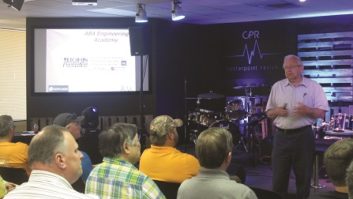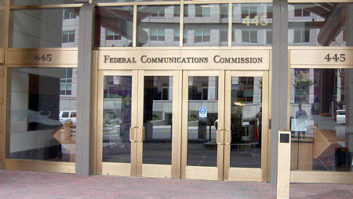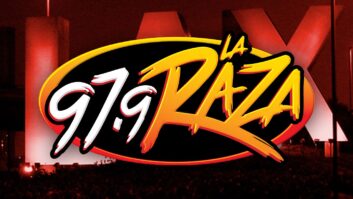The Society of Broadcast Engineers in June filed comments with the Federal Communications Commission relating to its proceeding regarding the re-auction and licensing of the 700 MHz D Block spectrum and creation of a nationwide, broadband, interoperable public safety network. The comments were submitted by SBE President Barry Thomas and General Counsel Christopher D. Imlay of Booth, Freret, Imlay & Tepper, P.C.
EAS: The Nation’s Mass Public Warning System
In 1996, the commission established and tested the Emergency Alert System as a replacement for the outdated Emergency Broadcast System, which had been operational since the 1960s. In 1996, the commission ordered that all radio, TV and cable television facilities must carry emergency messages from the president of the United States over their radio, TV and cable facilities.
SBE notes that the original FCC Notice of Inquiry on that subject asked if additional support spectrum would be needed for EAS distribution from warning centers to broadcasters. SBE also notes that while several commenters responded in the affirmative, the commission neither discussed nor acted on this issue in subsequent EAS Reports and Orders.
The commission also established a voluntary system within the EAS whereby broadcasters and cable operators could provide emergency alerts and notifications for severe weather, civil unrest, toxic and hazardous spills, and other emergency or disaster conditions at the state and local level. Based on this system, state and local warning centers were to originate EAS warnings.
The commission did not specify the means by which these warnings should be relayed to broadcasters and cable systems. State and local EAS committees (SECCs and LECCs) were left to figure that out for themselves.
In some cases, state and local communications narrowband radio channels were used. Many of these frequencies were in the low-band VHF or high-band VHF spectrum known for both interference and propagation problems. Other SECCs and LECCs decided to volunteer the use of Part 74 Broadcast Auxiliary Service frequencies.
Second Report and Order Will Greatly Enhance the EAS
While the EAS system has served us well over the last 12 years, the commission, in its Second Report and Order and Further Notice of Proposed Rule Making, 22 FCC Rcd. 13275 (2007) in EB Docket No. 04-296, established the basis for a new and improved Emergency Alert System taking advantage of the recently developed Common Alert Protocol as a method of providing better emergency information quickly and reliably through all warning systems.
The commission’s rules on the implementation of CAP into the EAS system are dependent on work by the Federal Emergency Management Agency. FEMA was tasked to define and adapt CAP 1.1 and CAP Protocols and how they will be used to improve the president’s ability to reach all American citizens. The goal as SBE perceives it is to enhance EAS, so that it can be an effective public warning system to complement and integrate with a growing number of other warning systems.
DTV Transition, Auctions and the D Block
On an independent track, the commission set into motion plans to move all TV broadcasters from their current analog mode into a digital mode that would allow closer mileage spacing for adjacent channel stations.
The net result of this move, which will be completed in February of 2009, is to free up a considerable amount of spectrum in the 700–800 MHz range, above Channel 51, which will be subject to auction for commercial use.
The 700 MHz auctions were largely completed in March 2008 but one block, the D Block, did not meet the commission’s minimum bid requirement. As a result, this 10 MHz of spectrum, in two segments, will be re-auctioned near the end of this year, or the beginning of 2009.
The D Block Spectrum was specifically carved out for shared use by commercial and public safety interests. It has been envisioned that the commercial entity winner of the D Block auction would build out a nationwide wireless network and offer shared use of this network to the public safety community.
‘LP’ Relay Model Will Not Work for Enhanced EAS
SBE has a longstanding record at the commission as an impartial engineering professional society. SBE provides coordination of broadcast auxiliary (BAS) frequencies in the Part 74 Broadcast Auxiliary Service at no cost to licensees or the public, and has been active before the commission in Emergency Alert System matters from the beginning.
As SBE studied the 2007 Second Report and Order requiring CAP implementation, it became increasingly clear that:
- The existing LP1/LP2 architecture that relays warnings to radio, TV and cable is not an efficient or viable way of taking advantage of CAP’s data-rich environment.
- LP1/LP2 relay architecture is in truth a remnant of the old EBS “daisy chain” architecture.
- Several State and Local EAS Committees have successfully replaced the LP1/LP2 model with wireless multipoint distribution from warning centers to broadcast and cable entry points
In the original EAS system, short data codes for events, locations and times of emergency, etc. had to be compressed in the 512-baud FSK protocol and transmitted in seconds as a relay from station to station. While that relay system has performed well, it will not support the data throughput required for CAP-Enhanced EAS.
For example, an EAS message for an AMBER alert (event code CAE) indicates that an AMBER alert has been issued in a particular area for a particular time. The current EAS data burst does not contain any information about the description (or photo) of the abducted child, possible routes of travel, vehicles of interest, etc. Under current EAS technology, information must be transmitted as an EAS audio message and as such, the text crawl on television stations and cable channels will not contain all the detailed information that is available.
With a CAP-Enhanced EAS, it will be possible to transmit messages with much more detail and specificity, not only for AMBER alerts, but also for severe weather situations and local emergencies where people at risk need timely details so they can take proper protective action.
A CAP message may contain hundreds or thousands of characters of information. At the 512 baud FSK data rate, transmitting such messages over the main channel of radio TV and cable facilities will take minutes, and will necessitate the airing of highly annoying data bursts.
These transmissions can and do drive away listeners and disrupt the station’s ability to quickly send audio alerts regarding the emergency at the exact time these services are most needed. It is therefore imperative that CAP messages from the emergency activation centers, be they federal, state or local, get to the broadcasters via a back channel multipoint distribution system instead of being relayed station-to-station as is now the case.
The challenge for an Enhanced EAS is to distribute these CAP messages from the emergency activation points at the federal, state or local level to the broadcasters and cable operators and finally to the public. As stated, the “daisy chain” LP1/LP2 relay of station-to-station, which has been the case with EAS, will not work for CAP.
SBE Proposal for EAS Relay Channel Spectrum
The Society of Broadcast Engineers respectfully requests that the commission set aside a total of just 100 kHz in the D Block spectrum; i.e. 50 kHz from the D Block spectrum in the lower band, and 50 kHz from the D Block spectrum in the upper band, exclusively for the Emergency Alert System nationwide.
This spectrum could be split into channels and reused across the country providing exclusive interference-free communications pathways between the emergency operating centers at the federal, state and local level and the broadcasters and cable operators.
SBE believes that allocating this spectrum is consistent with the congressional mandate that set up the D Block spectrum as a partnership between the emergency management community and commercial network operators. Interference will predictably be nil, and in the unlikely event that any is experienced, it can be easily mitigated on a case-by-case basis by volunteer SBE coordinators in each market, since this will be an exclusive allocation.
Further, SBE suggests that setting aside this limited amount of EAS support spectrum is quite obviously in the public interest, as it will enable the rapid and proficient deployment of CAP on a nationwide basis and improve the efficiency and performance of the EAS.
This is a once-in-a-lifetime opportunity for the commission to show leadership in support of the data capabilities of a CAP-enhanced Emergency Alert System.
To our knowledge, there is no other nationwide spectrum, other than the above-referenced 700 MHz allocation, that can serve this critical purpose. Without this spectrum, enhanced EAS will be badly crippled. Remote pickup and other BAS channels used by broadcasters in most markets, are badly overcrowded and are in any case narrowband channels. These channels need to be kept clear during emergencies to coordinate remote broadcasts from emergency scenes; the means by which most people in local areas receive their ongoing emergency information. Further, these RPU and BAS frequencies are licensed to broadcasters and not the emergency management community.
This proposal will have little or no impact on auction results, or the utility of the spectrum by potential bidders or public safety entities.
While SBE does not profess expertise in economics, it is apparent that allocating 100 kHz of the “D” Block, which amounts to exactly 1 percent of the 10 MHz D Block spectrum, will not significantly impact the results of the re-auction of the D Block spectrum.
The benefit to the public afforded by a vastly improved and more reliable Emergency Alert System, on the other hand, could well save countless lives and countless dollars in property damage by making the EAS a more data-rich, robust, and reliable system. The balance favors the enhancement of the EAS system.
Specific Spectrum Plan
SBE proposes that the bands 758.0 MHz to 758.05 MHz and 792.95 MHz to 793.0 MHz be set aside for specific and exclusive use by the Emergency Alert System nationwide.
This spectrum should be licensed to state and local emergency management agencies, which makes any reallocation of the spectrum completely unnecessary. Coordination of the use of this allocation should be a cooperative effort between local broadcasters and the emergency management community, and SBE is willing to participate in the database maintenance and administration, together with state and local agencies, to insure efficiency and maximum spectrum re-use.
Depending on whether these channels are to be used for data, text, still pictures or even slow-motion video, the actual channelization can be determined by building channels in 6.25 kHz blocks, to achieve the required channel bandwidth. State-to-state coordination can be handled by the SECCs in question, the National Emergency Management Association and FEMA.
SBE hopes that the commission will support this proposal and expedite its consideration, as it is crucial to implementing the 2007 Second Report and Order specifying CAP enablement across the country.
Summary
The Emergency Alert System is a vital part of America’s public warning mechanism, potentially affecting the life and safety of every citizen and resident. The EAS is the nation’s mass public warning system. Current relay methods using the LP model to get warnings to broadcast and cable entry points are inadequate for a CAP-enhanced EAS. Anything that can be done now to improve the Emergency Alert System must be considered to be clearly in the public interest.
SBE’s proposal should be given timely and serious consideration from the commission as it moves forward with D-Block re-auctions and licensing. The D-Block plan should include the use of dedicated spectrum for purposes that are at the heart of public warning improvement. Making this allocation will have little impact on the re-auction process since it amounts to 1 percent of the spectrum in the D-Block.
A number of agencies and organizations, including the Society of Broadcast Engineers, could manage these channels in partnership with state and local government warning centers, thereby creating no additional financial or management burden to the commission. Since these channels will be completely vacant as of February 2009 (except in Canadian and Mexican border areas), they could be dedicated quickly, so that their actual use could commence when the requested spectrum is available in any given area, but in any case, no later than February 2009.
Comment on this or any story. E-mail [email protected] with “Letter to the Editor” in the subject field.









